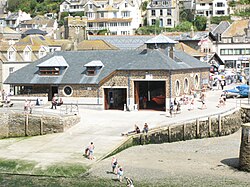Looe Lifeboat Station
| Looe Lifeboat Station | |
|---|---|
 | |
| General information | |
| Type | RNLI Lifeboat Station |
| Location | Looe |
| Address | Church End, West Rd, Looe PL13 1AH |
| Country | United Kingdom |
| Coordinates | 50°21′07″N 4°27′11″W / 50.352021°N 4.453168°W |
| Opened | 1866 |
| Owner | Royal National Lifeboat Institution |
| Website | |
| http://www.looelifeboats.co.uk/index.html | |
Looe Lifeboat Station is the base for Royal National Lifeboat Institution (RNLI) search and rescue operations at Looe, Cornwall in the United Kingdom.
History
To the east of Looe is the expanse of Whitsand Bay. While attempting to run for the safety of Plymouth Sound many sailing ships became embayed, unable to sail around Rame Head. Wrecks were frequent and Looe men made many rescues before the lifeboat station was established. In 1824, John Miller received the Institutes Silver Medal, and three others, monetary awards for rescuing seven men from Harmonie, wrecked in Whitsand Bay. Ten years later, in 1834, monetary awards and a Silver Medal was awarded for saving twelve crew from the Konigberg. A third Silver Medal was awarded in November, 1838 to William Jennings who swam to the brig Belissima, carrying a line, and saving thirteen men. Rescuing the crew of the Fletan resulted in a fourth Silver Medal in February 1851.[1]
A lifeboat house was erected in 1866 and the first lifeboat, Oxfordshire was paraded through the streets on 28 December 1866 and named by Mrs W H Carew.[2] The RNLI withdrew services from Looe in 1930 on the grounds that the lifeboats of Fowey and Plymouth could cover the area.[3]
From 1991 the RNLI stationed a lifeboat at Looe for the summer season and three years later the Spirit of the ROAC was housed in a temporary lifeboat house, provided by the East Looe Town Trust. A new lifeboat station was built on the old Albatross warehouse site on the quay, construction starting in Autumn 2002.[4]
Former lifeboats
'ON' is the RNLI's sequential Official Number; 'Op. No.' is the operational number painted onto the boat.
Pulling and sailing lifeboats
| ON | Name | Built | At Looe[5] | Class | Comments |
|---|---|---|---|---|---|
| Oxfordshire | 1866– | Paid for by the legacy of Sir John Willoughby, 4th Baronet[6] | |||
| Boys' Own No. 1 | Shadwell | 1882–1902 | Costs and equipment paid for by the readers of The Boy's Own Paper[7] | ||
| Ryder | Thames Ironworks | 1902–1930 |
Current lifeboats
Inshore lifeboats

| ON | Op. No. | Name | Built | At Looe | Class | Comments |
|---|---|---|---|---|---|---|
| B894 | Shiela and Dennis Tongue II | 2016– | Atlantic 85-class | |||
| D741 | Ollie Naismith | 2010– | D-class (IB1) |
See also
References
Bibliography
- Bird, Shiela (1991). Mayday! Preserving Life from Shipwrecks off Cornwall. Bradford on Avon: Ex Libris Press. ISBN 0 948578 31 9.

